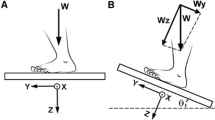Summary
Alignment of the body in typical symmetrical standing was studied by photographing fifteen subjects in profile on a reaction board. Two aspects of alignment were studied: (1) the anteroposterior position of the body landmarks of knee joint, hip joint, shoulder joint, and ear, compared to the ankle joint; and (2) the positions of the partial centers of gravity above the knee and hip, as a measure of how the body is balanced above these joints.
The knee, hip, shoulder, and ear were forward of the ankle in all subjects. On average, the knee was 3.8 (±2.0), the hip 6.2 (±1.3) the shoulder 3.8 (±1.9), and the ear 5.9 (±1.6) cm (± S.D.) anterior to the ankle. The positions of landmarks were positively correlated with one another but not highly. The position of the center of gravity could be predicted well from the positions of the landmarks within individual subjects' data, but not across subjects.
The centers of gravity above the knee and hip were calculated by subtracting the mass and position of the segments below the joint from the whole-body center of gravity. The center of gravity above the knee was located on average 1.4 (±1.1) cm in front of the joint, and that of the hip 1.0 (±1.6) cm behind the trochanter. Thus, at both knee and hip in typical standing, there exist slight gravitational torques tending to extend the joints.
Similar content being viewed by others
References
Akerblom B (1948) Standing and sitting posture. A.-B. Nordiska Bokhandeln, Stockholm
Asmussen E (1960) The weight-carrying function of the human spine. Acta Orthop Scand 29:276–290
Beck A, Killus J (1973) Normal posture of spine determined by mathematical and statistical methods. Aerosp Med 44:1277–1281
Clauser CE, McConville JT, Young JW (1969) Weight, volume, and center of mass of segments of the human body. AMRL Technical Report 69-70 Aerospace Med Res Lab, Wright-Patterson Air Force Base, Ohio
Dempster WT (1955) Space requirements of the seated operator. WADC Technical Report 55-159, Wright-Patterson Air Force Base, Ohio
Fox MG, Young DG (1954) Placement of the gravital line in anteroposterior standing posture. Res Quart 25:277–285
Hay JG (1973) The center of gravity of the human body. Kinesiol 3:20–44
Hellebrandt FA (1938) Standing as a geotropic reflex. Am J Physiol [Lond] 121:471–474
Joseph J, Nightingale A (1952) Electromyography of muscles of posture: leg muscles in males. J Physiol [Lond] 117:484–491
Klausen K, Rasmussen B (1968) On the location of the line of gravity in relation to L5 in standing. Acta Physiol Scand 72:45–52
Murphey DL, Blanton PL, Biggs NL (1971) Electromyographic investigation of flexion and hyperextension of the knee in normal adults. Am J Phys Med 50:80–90
Plagenhoef S (1971) Patterns of human motion. Prentice Hall, Englewood Cliffs, NJ
Smith JW (1956) Observations on the postural mechanism of the human knee joint. J Anat 90:236–260
Smith JW (1957) The forces operating at the human ankle joint during standing. J Anat 91:545–564
Soudan K, Van Audekercke R, Martens M (1979) Methods, difficulties and inaccuracies in the study of human joint kinematics and pathokinematics by the instant axis concept. Example: the knee joint. J Biomechanics 12:27–33
Steindler A (1955) Kinesiology of the human body. Thomas, Springfield, Illinois
Wells KF, Luttgens K (1976) Kinesiology: scientific basis of human motion, 6th edition. Saunders, Philadelphia, Pennsylvania
Author information
Authors and Affiliations
Rights and permissions
About this article
Cite this article
Woodhull, A.M., Maltrud, K. & Mello, B.L. Alignment of the human body in standing. Europ. J. Appl. Physiol. 54, 109–115 (1985). https://doi.org/10.1007/BF00426309
Accepted:
Issue Date:
DOI: https://doi.org/10.1007/BF00426309




